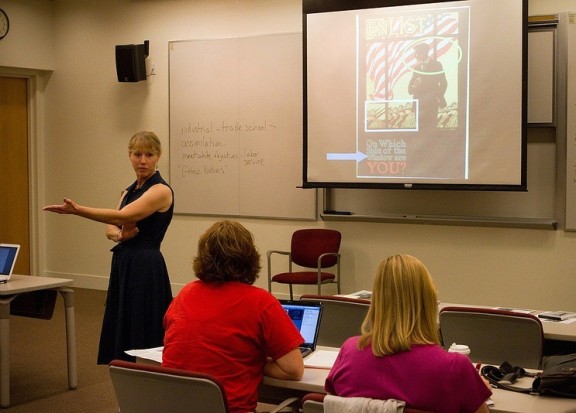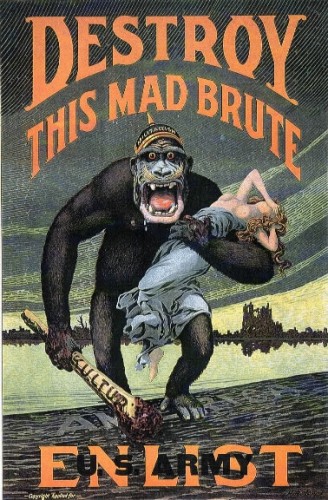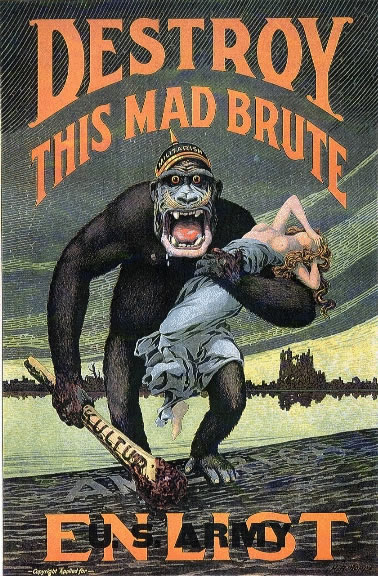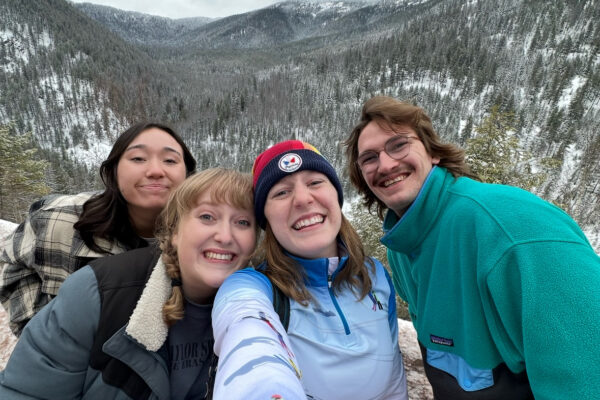The old photograph projected onto the overhead screen showed what seemed to be a merry bunch of solid Americans looking on and cheering at a happy occasion.
But that was just part of the story and literally half of the photo. In the next slide the entire photograph was revealed, and the classroom of history teachers were startled to see that it was in fact a lynching of an African-American man that had elicited the crowd’s joyful bearing.

Professor Jennifer Keene guides history teachers through an analysis of a WWI recruiting poster. (Photo/Max Kosydar ’14)
Yes, it was a bit of a trick pulled by Chapman University history professor Jennifer Keene, Ph.D. But social studies teacher Hanadi Shatara, one of 16 middle and high school teachers who attended a weeklong history conference here taught by Keene, says it will be a compelling conversation starter for her own students.
“I’m definitely going to use that with my students. I think it will be very powerful,” said Shatara, who teaches at a Philadelphia middle school. “I had never thought of looking at a photo that way.”
Discovering new ways of viewing and studying historic images was exactly the point of the Gilder Lehrman Institute of American History course held at Chapman July 29 through Aug. 4. This was the first time the award-winning institute, whose programs have been honored by the White House, hosted one of its courses at Chapman. Steven R. Schwartz, a Gilder Lehrman senior education fellow who led afternoon sessions during the week, said the institute was drawn to Chapman because of Keene.
“She’s worked with us in New York City and around the country and we invited her to do a summer seminar here on teaching American history with images because of her expertise in that area,” Schwartz said.

Among the images analyzed in Keene’s course was this World War I recruiting poster.
Keene is co-author of
Visions of America: A history of the United States
, a textbook exploring U.S. history with a special emphasis on a vast range of images, from the earliest political cartoons and etchings to contemporary photojournalism and film. Today’s youth may think that through social media they are inventing the power of visual messaging, but in fact Americans have been at this game for generations, Keene said.
“All of this comes as a revelation – they assume that they are uniquely a ‘visual generation’. Teaching with images is not ‘dumbing’ down history; humans have always communicated visually and by ignoring visual media we have too long neglected a crucial component of the human experience,” Keene said.
During their course, the attendees also heard a guest lecture by Marilyn Harran, Ph.D., the Stern Chair in Holocaust Education at Chapman, toured the Sala and Aron Samueli Holocaust Memorial Library and had a discussion meeting with Leon Leyson, a recipient of an honorary doctorate from Chapman University and the youngest surviving member of Schindler’s List.
Maura Henry, who teaches English as a Second Language in a New York City public school, says the lessons with visual images will be a particularly useful new tool in her teaching kit.
“Most of the other classes my students attend are lecture,” Henry said. “So to come into a room and have these vibrant and really exciting or controversial images that can really be engaged with will be really exciting.”
Gilder Lehrman chose 15 teachers from throughout the United States, plus one teacher from a school in Taiwan, for Keene’s course. Founded in 1994 by Richard Gilder and Lewis E. Lehrman, the institute is a nonprofit devoted to the improvement of history education. The Institute’s programs have been recognized by awards from the White House, the National Endowment for the Humanities, and the Organization of American Historians.
Teachers get a Keene view of history with images, pictures during campus conference





[…] Read more in Happenings … […]